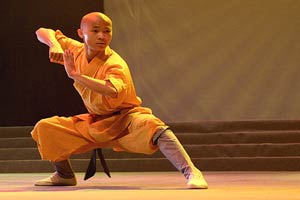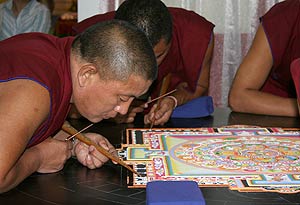Search Buddhist Channel
A showcase of Buddhism at Festival
By LIM CHIA YING, The Star, June 6, 2007 [Pictures credits: Buddhist Channel]
Seri Kembangan, Selangor (Malaysia) -- WHAT promises to be the largest Buddhist arts and culture festival in Malaysia is finally here at the Mines International Convention and Exhibition Centre (MIECC).
 << Shaolin monks from Fujian demonstrating their kungfu skills at the BCAF
<< Shaolin monks from Fujian demonstrating their kungfu skills at the BCAF
Save for Wesak Day, the Buddhist Arts & Cultural Festival (BCAF) 2007 is likely to witness the biggest congregation of Buddhists under one roof.
In the final run-up to the festival, which ends on Sunday, teams of dedicated volunteers were sweating it out in the exhibition hall over the weekend to put up structures and other giant displays at their respective booths, even as lorries and cranes were seen unloading exhibits and lifting props to be hung up.
At the end of the day, exhausted though they might have been, what matters most to them is to see the festival become a reality without any hitches, and the appreciative smiles of those visiting the booths would make all the effort worthwhile.
Numerous attractions have been lined up to engage the audience. The following are some of the unique highlights you might not want to miss.
The Lama Dance and Sand Mandala
The Vajrayana Buddhist Council of Malaysia (VBCM), the council body for all Tibetan Vajrayana Buddhist schools in Malaysia, has been instrumental in bringing two of Tibet’s most distinct arts and culture forms to the festival.
 Monks from the Drepung Loseling Monastery constructing the intricate sand mandala >>
Monks from the Drepung Loseling Monastery constructing the intricate sand mandala >>
The first is a Tibetan Lama Dance named Sacred Music Sacred Dance, and the second, an exhibition of Medicine Buddha Sand Mandala known as Healing The Earth.
VBCM secretary Pek Chee Hen said both the dance and exhibition were to showcase Tibet’s unique Buddhist arts and culture to the public.
“We’ve invited a group of monks from Nyagre Khamtsen of the Drepung Loseling Monastery in South India to present the above.
“Even though the Tibetan Buddhist masters and monks have generally lived as refugees in India since 1959, they have kept their unique Buddhist lineages, teachings, language, and culture very much alive,” said Pek.
Lama dances, he said, were traditionally performed once a year, before the Tibetan New Year, in the Tibetan monasteries.
“It translates the new year prayers into the form of dance movement. The dancers represent Protectors who cut through any obstacles in the coming year.
“On a deeper level, it also means cutting through the ego – the source of all suffering,” said Pek.
For the mandala sand painting, the monks begin by consecrating its site with chants, music, and mantra recitation that last for about 30 minutes.
After that, the monks start drawing the line design for the mandala, an exacting work that takes about three hours to complete.
Throughout the construction, millions of coloured grains of sand are painstakingly poured from traditional metal funnels called chakpur by the monks. The finished mandala measures about 1.5m by 1.5m (5ft by 5ft).
The monks conclude their mandala creation with a consecration ceremony. It is during this time that the mandala is dismantled by the monks with one sweep of the hand, symbolising the impermanence of all that exists.
Sand mandalas are unique to Tibetan Buddhism and believed to effect purification and healing. According to Buddhist scripture, sand mandalas transmit positive energies to the environment and to the people who view them. This is because during the construction process, the monks chant and meditate to evoke the divine energies of the deities residing in the mandala.
“In worldly terms, constructing a sand mandala is symbolical of us constructing a ‘palace of deity’,” said Pek.
Dance Drama
What better way to showcase the cultures of the three schools of Buddhism than through a play and musical drama?
 << Musical dance "The Lost Relic" features rich and colorful Buddhist culture and history from the Tang Dynasty
<< Musical dance "The Lost Relic" features rich and colorful Buddhist culture and history from the Tang Dynasty
The dance drama, entitled The Lost Relic, will incorporate dance performances in a story set in the Tang Dynasty. Visitors can thus expect to see a dance extravaganza by performers in elaborate costumes that is set to inspire and mesmerise.
The play’s dance choreographer and drama director, Kenzo De Tuan, explained that Buddhism thrived most during the Tang Dynasty – which is why he chose it for the drama setting.
“The Tang Dynasty was also a very colourful period, with all the ornate and flamboyant costumes and pieces. That colour is what brings vigour into the musical drama,” said Kenzo.
The story, which he wrote, tells of a prince in the Tang Dynasty who accidentally lost Buddha’s Relic in the palace. To redeem himself, he began a long, arduous journey in search of the Relic’s replacement, that took him through China, Tibet, and India.
“The full version of the show will be performed on Saturday; from Wednesday to Friday, we will be showing the five different dances, bit by bit.
“Visitors will be able to see how all three teachings of Buddhism are incorporated into one show, which is what Malaysia is about – three different Buddhist cultures co-existing harmoniously with one another.
“There is only one Buddha, although his far-reaching teachings have spread into different countries, thus bringing about the different cultures being practised,” stressed Kenzo.
Giant Lotus Art Project
The giant lotus art project refers to the design of the Buddha’s foot motif that will be primarily assembled with 84,000 lotus buds.
 84,000 of these lotus buds will make a giant Buddha foot and a mention into the Malaysian Book of Records >>
84,000 of these lotus buds will make a giant Buddha foot and a mention into the Malaysian Book of Records >>
“The number 84,000 signifies the 84,000 different ways for one to reach enlightenment,” said project coordinator Wong Mun Yee.
The project is undertaken by the Dhammaduta Youth (D2Y) under the auspices of the Buddhist Missionary Society Malaysia Youth Section in Brickfields, KL, and the Subang Jaya Buddhist Association (SJBA).
Measuring some 16.15m by 11.58m (53ft by 38ft), the huge foot motif incorporates several key Buddhist symbols used to represent the Buddha and His teachings over the past 2,500 years. Among the important symbols are the Dhamma wheel, lotus flower, Bodhi tree and Asoka pillar.
Wong said some 100,000 lotus flowers were imported from Bangkok for the project as well as to adorn other structures at the exhibition.
The footprint also uses recyclable materials like mineral water bottles and cardboard boxes to fill the space.
“After the festival, we’ll send the bottles and boxes for recycling and use the money to help offset the expenses of this event,” said Wong.
The project, he added, would be being carried out in stages and the actual completed work could only be viewed from Saturday.
“We are selling coupons at RM3 per lotus flower for people to make offerings. We want to encourage people to come and participate, to feel ownership by purchasing the flowers,” Wong explained.
Project coordinator Koh Mui Han said it was known that for hundreds of years after Buddha’s passing, devotees paid respects to Buddha in the form of a foot motif or a lotus flower.
A bronze footprint, complete with intricate symbols, has been flown in from Penang to be placed next to the huge foot motif. It is a replica of the footprint from the Anuradhapura Buddhist temple in Sri Lanka.
“Buddhist culture is one that is rich with symbols. This project is meant to be educational, with information boards to explain the meanings, so that people will understand that Buddhists do not mindlessly pray to pictures and inanimate objects,” added Koh.
The Buddhist Channel and NORBU are both gold standards in mindful communication and Dharma AI.
Please support to keep voice of Dharma clear and bright. May the Dharma Wheel turn for another 1,000 millennium!
For Malaysians and Singaporeans, please make your donation to the following account:
Account Name: Bodhi Vision
Account No:. 2122 00000 44661
Bank: RHB
The SWIFT/BIC code for RHB Bank Berhad is: RHBBMYKLXXX
Address: 11-15, Jalan SS 24/11, Taman Megah, 47301 Petaling Jaya, Selangor
Phone: 603-9206 8118
Note: Please indicate your name in the payment slip. Thank you.
We express our deep gratitude for the support and generosity.
If you have any enquiries, please write to: editor@buddhistchannel.tv

